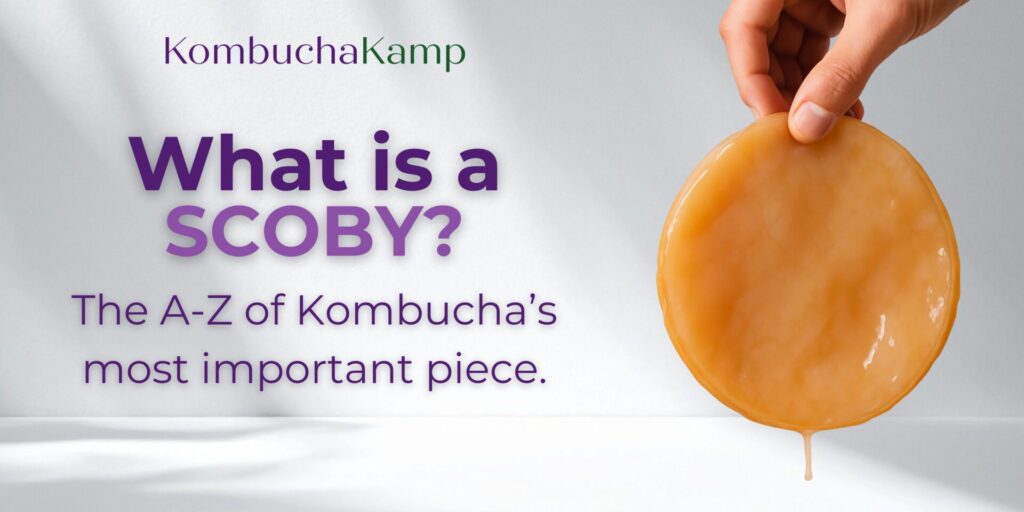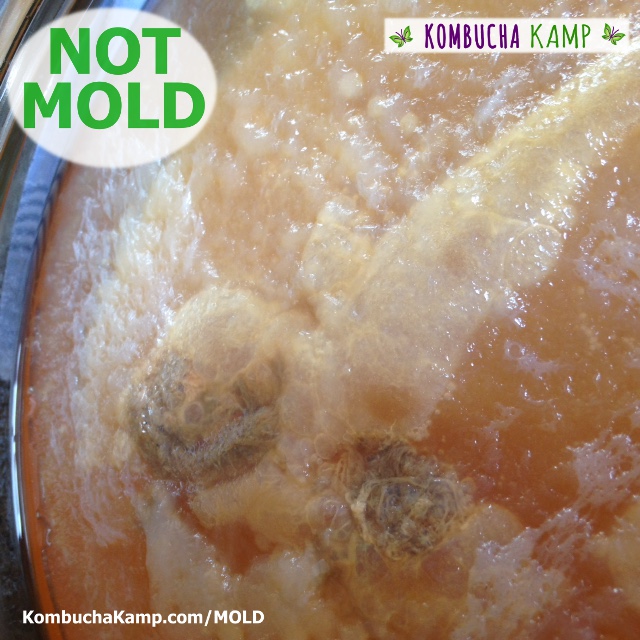
Every great Kombucha story starts with the same strange character:
a squishy, jelly-like disc that looks like it crashed in from another planet.
That’s the SCOBY – the living culture that turns simple sweet tea into tangy, fizzy, probiotic Kombucha.
Maybe you’ve seen one floating in a brew, or lurking at the bottom of a store-bought bottle. Maybe you’re holding one in your hands right now, wondering, “What exactly ARE you… and what am I supposed to do with you?”
This guide is your SCOBY HQ – a hub you can return to as your brewing journey evolves:
Let’s start with the basics.

“SCOBY” stands for:
Summed up, a SCOBY is a community of microbes living together in a rubbery, cellulose “raft” (called a pellicle) that forms on top of fermenting sweet tea. It’s slippery, slimy, sometimes has stringy bits dangling from the bottom, and can be (understandably) off-putting for the new brewer. But trust us: you’ll get used to it.
And who knows? Maybe long-term handling of SCOBYs can lead to some fabulous beauty results, as well? (There’s a cool story about Japanese workers in sake factories leading to the discovery of fermented ingredients’ anti-aging and skin protective properties! Here’s a great study demonstrating how.)
A Kombucha SCOBY is:
Together, they:
Think of the SCOBY as a living brewing assistant:
The SCOBY is important, but the liquid culture (your mature Kombucha starter) is equally vital. Together they create the conditions for safe, consistent fermentation.
Here’s the short, kitchen-table version of Kombucha science:

The result is a drink that is:
The SCOBY is simply the physical expression of that living ecosystem.
Not all SCOBYs are the same. You’ll encounter:
The culture currently living in your main brewing vessel. It may be thick, layered, or have dark streaks of yeast. Each SCOBY is like a fingerprint: completely unique in appearance.
A new layer that forms on the surface of each batch. Over time, these stack into a SCOBY “pancake.”
You can gently peel layers apart:
Cultures stored in a separate jar with mature Kombucha to:
Each and every new batch of Kombucha will produce a Baby SCOBY that can be allowed to mature in a well-tended SCOBY Hotel. (Read our SCOBY Hotel How To Guide for more info on this.)
Occasionally, a SCOBY-like pellicle will form on unpasteurized drinks (including store-bought raw Kombucha and the “Mother” in bottles of Apple Cider Vinegar) or in sugary tea left exposed.
This is a “wild” culture – fascinating, but less predictable. For consistent, safe brewing, we recommend purpose-grown Kombucha SCOBYs.
(Fun Fact: Kombucha Kamp SCOBYs are DNA-Sequenced, heirloom cultures that have been specifically bred to produce consistent, delicious results each and every batch.)
Prepare for some honesty: a healthy SCOBY can look weird.
If you’re expecting something cute and Instagrammable, Kombucha may test your comfort zone.


Healthy SCOBYs often show:
It may:
All of those are fine. The new baby culture will always form at the surface of the brew.
These are not normal:
If you see anything fuzzy or vividly colored on the surface:
🛑 Stop. Do not taste. Discard the entire batch (including SCOBY) and start over with fresh culture and starter liquid.
Check out our comprehensive (and ever expanding) Mold Gallery for some really great reference photos so that you can be 100% sure that your culture is safe. Members can enjoy the full gallery and upload their own mold pictures to help the community. Support KKamp’s mission and become a Bubbles+ Member here.
Here are some of the most common SCOBY questions—and quick answers:
Often occurs when:
What to do:
Improve temperature control, leave the vessel undisturbed, and give it time. Next batches usually form thicker pellicles.
This often happens after many brew cycles as yeast builds up.
What to do:
Peel off older bottom layers and either:
Keep fresher, lighter layers in your active brew.
Not at all. SCOBYs are not goldfish.
A sunk SCOBY is normal; the new baby SCOBY will form on top.
Textured, lumpy, or “brain-like” SCOBYs are also normal variations of cellulose growth.
Focus on:
This is a red flag.
If your brew smells like:
👉 Discard and start again. Trust your nose.
For a comprehensive guide to SCOBY Hotels, refer to our Complete SCOBY Hotel Guide. Put simply, a SCOBY Hotel is simply:
A jar filled with SCOBYs + enough mature Kombucha to keep them submerged at room temperature.
If it turns very vinegary, it’s still usable as starter liquid for future brews.

Once your brewing game is strong, you will eventually face the SCOBY Abundance Problem.
Good news: SCOBYs are incredibly versatile. Here are some fun, practical, and occasionally wild ways to use them.
Slice SCOBYs into thin strips, marinate with:
Then dehydrate at low temperature until chewy.
The texture is somewhere between fruit leather and vegan jerky.
Some brewers dehydrate SCOBYs and offer small amounts as dog treats. They’re rich in fiber and microbes, but not all pets tolerate them. That said, if you’re interested in more information surrounding ways that you can incorporate fermented foods into your pets’ diet for enhanced health and wellbeing, check out our Kombucha For Your Pooch-A Page.
Blend SCOBY with:
Spread on dehydrator trays or parchment-lined sheets and dry until leathery.
Cut into strips for a tangy, probiotic snack.
To the right is a feature that Bon Appétit Magazine did on our fruit leather recipe… with a special shoutout for The Big Book of Kombucha!
SCOBYs are full of:
Some fans blend a piece of SCOBY with a bit of Kombucha and apply as:
Always patch-test first and avoid open wounds or active irritation.
Check out our Kombucha Spa Day Page for more great DIY beauty treatments!
Dried SCOBY can be surprisingly strong and flexible. Crafters have used it to make:
If you love DIY, SCOBY offers endless experimentation.
SCOBYs break down beautifully in compost or directly in the garden:
They provide organic matter and a little microbial diversity to the soil.
Sometimes the most practical “use” is the simplest:
Use extra SCOBYs and the liquid they live in to:
Not all SCOBYs are created equal.
For consistent, safe brewing, you want a culture that is:
At Kombucha Kamp, our cultures are:
⭐ Explore: Kombucha Starter Kits & SCOBY Cultures
⭐ Upgrade: Continuous Brew Systems
Q: Is SCOBY a fungus or mushroom?
A: No. It’s a symbiotic culture of bacteria and yeast in a cellulose matrix—not a mushroom or mycelium.
Q: Can you make Kombucha without a SCOBY?
A: You can sometimes grow a SCOBY from raw, unflavored store-bought Kombucha, but for best results we recommend starting with a proven SCOBY and strong starter liquid.
Q: Are SCOBYs edible?
A: Yes. SCOBYs are technically edible and used in treats, jerky, and snacks. Texture can be challenging; always introduce slowly.
Q: How long does a SCOBY last?
A: With proper care, SCOBYs can last for years. They may darken, layer, and evolve but remain usable as long as they smell clean and are mold-free.
Q: How do I know if my SCOBY died?
A: There’s no dramatic “moment of death.” Instead, look for:
Q: Can I use herbal tea or Earl Grey with my SCOBY?
A: Stick to Camellia sinensis (black, green, white, oolong). Herbal teas lack nutrients, and Earl Grey contains oils that can stress the culture.
Q: Do I need to refrigerate my SCOBY?
A: No. SCOBYs do best at room temperature in a SCOBY Hotel. Refrigeration slows them down and can weaken the culture over time.
Your SCOBY is more than “the slimy thing in the jar.”
It’s a living community, a little fermentation teacher, and – if you let it – one of the most fascinating allies in your kitchen. It’s been growing and changing alongside humanity for millennia and is a collection of organisms worth reverence for the many benefits it provides to humanity.
Treat it with care, curiosity, and respect, and it will reward you with years of delicious, bubbly tea.